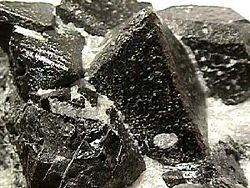Magnetite
| Magnetite | |
|---|---|
 Magnetite from the Kola Peninsula, Russia |
|
| General | |
| Category | Mineral |
| Chemical formula | iron(II,III) oxide, Fe3O4 |
| Identification | |
| Color | Black, greyish |
| Crystal habit | Octahedral, fine granular to massive |
| Crystal system | Isometric |
| Cleavage | Indistinct |
| Fracture | Uneven |
| Mohs Scale hardness | 5.5 - 6.5 |
| Luster | Metallic |
| Refractive index | Opaque |
| Streak | Black |
| Specific gravity | 5.17 - 5.18 |
| Major varieties | |
| Lodestone | Magnetic with definite north and south poles |
Magnetite is a ferrimagnetic mineral with chemical formula Fe3O4, one of several iron oxides and a member of the spinel group. The chemical IUPAC name is iron(II,III) oxide and the common chemical name ferrous-ferric oxide.
The Curie temperature of magnetite is about 580°C. Magnetite is the most magnetic of all the naturally occurring minerals on Earth, and these magnetic properties led to lodestone being used as an early form of magnetic compass. Magnetite typically carries the dominant magnetic signature in rocks, and so it has been a critical tool in paleomagnetism, a science important in discovering and understanding plate tectonics. The relationships between magnetite and other iron-rich oxide minerals such as ilmenite, hematite, and ulvospinel have been much studied, as the complicated reactions between these minerals and oxygen influence how and when magnetite preserves records of the Earth's magnetic field.
Magnetite has been very important in understanding the conditions under which rocks form and evolve. Magnetite reacts with oxygen to produce hematite, and the mineral pair forms a buffer that can control oxygen fugacity. Commonly igneous rocks contain grains of two solid solutions, one between magnetite and ulvospinel and the other between ilmenite and hematite. Compositions of the mineral pairs are used to calculate how oxidizing was the magma (i.e., the oxygen fugacity of the magma): a range of oxidizing conditions are found in magmas and the oxidation state helps to determine how the magmas might evolve by fractional crystallization.
Small grains of magnetite occur in almost all igneous rocks and metamorphic rocks. Magnetite also occurs in many sedimentary rocks, including banded iron formations. In many igneous rocks, magnetite-rich and ilmenite-rich grains occur that precipitated together from magma. Magnetite also is produced from peridotites and dunites by serpentinization.
Magnetite is a valuable source of iron ore. It dissolves slowly in hydrochloric acid.
Distribution of deposits
Magnetite is sometimes found in large quantities in beach sand. Such mineral sands or iron sands or black sands are found in various places such as California and the west coast of New Zealand. The magnetite is carried to the beach via rivers from erosion and is concentrated via wave action and currents.
Huge deposits have been found in banded iron formations. These sedimentary rocks have been used to infer changes in the oxygen content of the atmosphere of the Earth.
Large deposits of magnetite also are found in Kiruna, Sweden, the Pilbara region in Western Australia, and in the Adirondack region of New York in the United States. Deposits are also found in Norway, Germany, Italy, Switzerland, South Africa, India, Mexico, and in Oregon, New Jersey, Pennsylvania, North Carolina, Virginia, New Mexico, Utah, and Colorado in the United States. Recently, in June 2005, an exploration company, Candero Resources, discovered a vast deposit of magnetite-bearing sand dunes in Peru. The dune field covers 250 km², with the highest dune at over 2000 m above the desert floor. The sand contains 10% magnetite[1].
Biological occurrences
Crystals of magnetite have been found in some bacteria (e.g., Magnetospirillum magnetotacticum) and in the brains of bees, of termites, of some birds (e.g., the pigeon), and of humans. These crystals are thought to be involved in magnetoreception, the ability to sense the polarity or the inclination of the earth's magnetic field, and to be involved in navigation. Also, chitons have teeth made of magnetite on their radula making them unique among animals. This means they have an exceptionally abrasive tongue with which to scrape food from rocks.
The study of biomagnetism began with the discoveries of Caltech paleoecologist Heinz Lowenstam in the 1960s.
Preparation as a ferrofluid
Magnetite can be prepared in the laboratory as a ferrofluid in the Massart method by mixing iron(II) chloride and iron(III) chloride in the presence of sodium hydroxide.
See also
- Ferrite
- Hematite
- Wüstite
- Mineral redox buffer
- Magnesia
- Maghemite
- Bluing (steel) is a process in which steel is partially-protected against rust by a layer of magnetite.
- Thermite
ReferencesISBN links support NWE through referral fees
- Hurlbut, Cornelius S.; Klein, Cornelis, 1985, Manual of Mineralogy, 20th ed., Wiley, ISBN 0-471-80580-7
- Webmineral data
- Mineral galleries
- Heinz A. Lowenstam and Stephen Weiner, On Biomineralization, Oxford University Press, USA (1989) ISBN 0-19-504977-2
- Shih-Bin Robin Chang' and Joseph Lynn Kirschvink, Magnetofossils, the Magnetization of Sediments, and the Evolution of Magnetite Biomineralization, Ann. Rev. Earth Planet. Sci. 1989. 17:169-95 PDF file
- Bio-magnetics
- Magnetic bacteria (Italian)
- History of Magnetite Mining in the NJ Highlands
- Magnetite mining in New Zealand
- Magnetite mining in Santa Cruz
- Peruvian sand dunes
Credits
New World Encyclopedia writers and editors rewrote and completed the Wikipedia article in accordance with New World Encyclopedia standards. This article abides by terms of the Creative Commons CC-by-sa 3.0 License (CC-by-sa), which may be used and disseminated with proper attribution. Credit is due under the terms of this license that can reference both the New World Encyclopedia contributors and the selfless volunteer contributors of the Wikimedia Foundation. To cite this article click here for a list of acceptable citing formats.The history of earlier contributions by wikipedians is accessible to researchers here:
The history of this article since it was imported to New World Encyclopedia:
Note: Some restrictions may apply to use of individual images which are separately licensed.